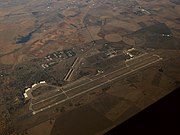| Beja Air Base | |||
|---|---|---|---|

| |||
| IATA: BYJ – ICAO: LPBJ | |||
| Summary | |||
| Airport type | Military | ||
| Serves | Beja | ||
| In use | 1964 - present | ||
| Elevation AMSL | 636 ft / 194 m | ||
| Coordinates | 38°04′44″N 007°55′57″W / 38.07889°N 7.9325°WCoordinates: 38°04′44″N 007°55′57″W / 38.07889°N 7.9325°W | ||
| Website | |||
| Map | |||
| Location within Portugal | |||
| Runways | |||
| Direction | Length | Surface | |
| m | ft | ||
| 01L/19R | 3,450 | 11,319 | Asphalt |
| 01R/19L | 2,951 | 9,682 | Asphalt |
| Sources: Portuguese AIP[1] | |||
Beja Air Base (Portuguese language: Base Aérea de Beja
- IATA
- BYJ, ICAO: LPBJ), designated as Air Base No. 11 (Portuguese language: Base Aérea Nº 11
, BA11) is one of the most important military airbases in Portugal, 9 km (5.6 mi) northwest of Beja,[1] 100 km (62 mi) north of Algarve. It is used by the Portuguese Air Force and has two parallel runways in the 01/19 direction, the biggest being 3,450 m × 60 m (11,320 ft × 200 ft).[1] The base is home to two training squadrons, one helicopter squadron and one maritime patrol squadron.
History[]
The base was established on 21 October 1964, originally built to serve as a training facility for the Luftwaffe, due to airspace limitations within West Germany.[2] The Luftwaffe operated from the airbase until 1993, during which period it was used particularly for weapons training.[3] In 1987 the Portuguese Air Force's 103 Squadron using Lockheed T-33 and Northrop T-38 aircraft was relocated from Montijo. After their arrival, the base started to host a mixed array of fixed and rotary-wing trainers, as well as maritime patrol aircraft.[2] From 1993 to present, the Portuguese Air Force has operated Dassault/Dornier Alpha Jet aircraft from the airbase, which were donated by Germany as compensation for leaving the air base in 1993.[3]
Current state[]
The base is now modern and well-equipped, employing around 1,000 personnel.[2] It comprises two parallel runways running north/south (01L/19R, 01R/19L, the largest being 3,450 m (11,320 ft) in length and the other 2,951 m (9,682 ft) long. A third parallel runway/taxiway supports its helicopter facilities.[2] Beja Air Base is one of the most important training facilities of the Portuguese Air Force and during 2008 operated over 70,000 flying hours.[4] The first training phase comprises flying on Socata TB 30 Epsilon aircraft, while the final course is made on Alpha Jets of the 103 Squadron, which currently has 15 operational aircraft.[5] The 552nd Squadron operates 12 Alouette III helicopters tasked with tactical transport for the army, helicopter pilot training and occasional search and rescue. The Alouette helicopters made a total of 314,000 flight hours and are due to be replaced by Agusta AW109 or Eurocopter Colibri by 2011.[6] The 601st Squadron currently uses 7 P-3 Orion aircraft which provide 24/7 search and rescue and anti-submarine warfare cover.[7]
Construction of a civilian terminal was undertaken in 2009, with this facility being aimed at low-cost carriers.[8]
Tenant units[]
- 103 Sqn. "Caracóis" (Snails) — complementary flying training and operational transition training[5]
- 552 Sqn. "Zangões" (Drones) — tactical air transport operations and complementary flying training in helicopters[6]
- 601 Sqn. "Lobos" (Wolves) — maritime patrol squadron[7]
Notes[]
- ↑ 1.0 1.1 1.2 AIP Part 3 - AD 2 Aerodromes Archived 2012-04-15 at the Wayback Machine.
- ↑ 2.0 2.1 2.2 2.3 Air Forces Monthly, p. 36.
- ↑ 3.0 3.1 Barreira, Victor (20 November 2017). "Portugal to phase out Alpha Jet A". Archived from the original on 20 November 2017. https://archive.is/6pYbU. Retrieved 20 November 2017.
- ↑ Air Forces Monthly, p. 38.
- ↑ 5.0 5.1 Air Forces Monthly, p. 39.
- ↑ 6.0 6.1 Air Forces Monthly, p. 40.
- ↑ 7.0 7.1 Air Forces Monthly, p. 41.
- ↑ Air Forces Monthly, p. 37.
References[]
- Base Tour: Beja, Portugal - Portuguese Super Base, Air Forces Monthly magazine, March 2009 issue.
External links[]
- Portuguese Air Force - Air Base 11, Beja (English)
- Empresa de Desenvolvimento do Aeroporto de Beja (Portuguese)
- Airliners.net - Photos taken at Beja Air Base
The original article can be found at Beja Airbase and the edit history here.
